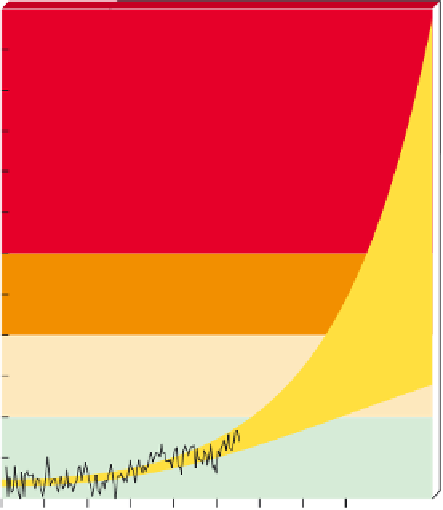Environmental Engineering Reference
In-Depth Information
temperature. Figure 16-7 (p. 372) gives a greatly sim-
plified summary of some of the interactions in the
global climate system.
Such models provide scenarios of what is
very
likely
(90-99% probability) or
likely
(66-89% probabil-
ity) to happen to the average temperature of the
troposphere based on various assumptions and data
fed into the model. How well the results correspond to
the real world depends on the assumptions of the
model (based on current knowledge about the systems
making up the earth, oceans, and atmosphere) and the
accuracy of the data used.
In 1990, 1995, and 2001, the IPCC published re-
ports that evaluated how global temperatures have
changed in the past (Figure 16-2) and made forecasts of
how they are likely to change during this century. The
2001 report included two important findings.
First,
“there is new and stronger evidence that most of the
warming observed over the last 50 years is attributable
to human activities.”
Second,
it is
very likely
(90-99%
probability) that the earth's mean surface temperature
will increase by 1.4-5.8°C (2.5-10.4°F) between 2000
and 2100 (Figure 16-8). Other major scientific advisory
bodies, such as the U.S. National Academy of Sciences,
have reached similar conclusions.
More recent runs of various climate models sug-
gest that the most likely temperature increase during
this century will be in the range of 2.5°C (4.5°F) to
3.5°C (6.3°F)—a major increase in such a short period.
6.0
5.5
5.0
4.5
4.0
3.5
3.0
2.5
2.0
1.5
1.0
0.5
0
1850 1875 1900 1925 1950 1975 2000 2025 2050 2075 2100
Year
Figure 16-8
Science:
comparison of measured changes
in the average temperature of the atmosphere at the earth's
surface between 1860 and 2004 and the projected range of
temperature increase during the rest of this century. Climate
models project a 90-99% probability that such changes will
occur. (Data from U.S. National Academy of Sciences, National
Center for Atmospheric Research, and Intergovernmental Panel
on Climate Change)
Science, Economics, and Ethics: Why Should
We Be Concerned about a Warmer Earth?
A rapid increase in the temperature of the troposphere
during this century would give us little time to deal
with its harmful effects.
Climate scientists warn that the concern is not just
about a temperature change but how rapidly it occurs.
Most past changes in the temperature of the tropo-
sphere took place over thousands of years to a hun-
dred thousand years. The problem we face now is a
fairly sharp projected increase in temperature of the
troposphere during this century or less than the typical
span of a human lifetime (Figure 16-8). According to
the IPPC, there is a 90-99% chance that this will be the
fastest temperature change of the past 1,000 years.
Such rapid change can affect the availability of
water resources by altering rates of evaporation and
precipitation. It can shift areas where crops can be
grown; alter some ocean currents; increase average sea
levels and flood some coastal wetlands, cities, and
low-lying islands; alter the structure and location of
some of the world's biomes; and affect the economic
and social fabric of societies throughout the world.
The projected increase in the earth's temperature
within a few decades or a century gives us little time to
deal with its effects.
In addition, climate scientists warn that climate
rarely changes in a linear fashion. Large, abrupt
changes in climate have repeatedly occurred in past.
For example, temperature changes as great as 10°C
(18°F) in a decade have occurred in some locales, often
spurred by sudden shifts in oceanic circulation.
In 2002, a National Academy of Sciences study
suggested that the temperature of the troposphere
could increase drastically in only a decade or two. This
conclusion was based on analysis of greenhouse gases,
such as carbon dioxide and methane, in ice cores and
analysis of pollen and zooplankton buried in ocean
sediment that revealed sudden climate flips through-
out the last ice age—from about 70,000 to 11,500 years
ago—when vast sheets of ice blanketed much of the
northern hemisphere.
The National Academy of Sciences report lays out
a nightmarish worst-case scenario in which human ac-
tivities or a combination of human activities and nat-
ural climate changes succeed in flipping one of the
earth's climate switches and triggering a new abrupt
change. It describes ecosystems suddenly collapsing,
low-lying cities being flooded, forests being consumed
in vast fires, grasslands dying out and turning into dust
bowls, much wildlife disappearing, more frequent and










